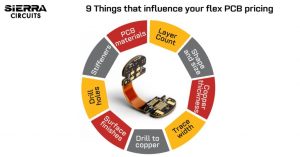Design of Rigid Flex Circuits
Rigid flex circuits combine the benefits of rigid PCBs with flexible interconnects. They reduce the number of connections needed in a design and provide more space for components. They also offer greater reliability and signal integrity, and can help to reduce the overall system weight and size.
A rigid flex circuits PCB is made from a single or two-sided printed circuit board with a rigid section and a conductive flex area. The flex areas are connected to the rigid sections through plated vias (through-holes that are filled with copper) or blind and buried vias (metalized holes that connect internal layers without passing through the outer layer).

The flex sections of the PCB can be arranged in a variety of ways. They can be embedded between the rigid sections or they may span the entire width of the board. The PCB can also contain additional rigid or flex sections on the top and bottom, which is called a sandwich construction.
Factors Influencing the Design of Rigid Flex Circuits
Rigid flex circuit boards are used in medical and aerospace applications where flexibility is required and reliability is essential. They are also popular for consumer electronic devices such as tablets and smartphones.
Several factors influence the current carrying capacity of a rigid-flex circuit. The operating environment, the amount of current flowing through traces, and the bending ratio of the circuit board should all be taken into consideration when designing the layout. The conductor pattern should also be considered, with curved traces able to carry more current than straight ones.
In addition, the manufacturing process is another factor that can affect the current-carrying capability of a rigid flex circuit. Precise etching and plating techniques can ensure proper trace widths and thicknesses, which can contribute to higher current-carrying capabilities.
Rigid-flex PCBs must also be designed to handle temperature fluctuations. The thermal expansion of the flex section can cause stress and elongation in the conductors, which can lead to a loss of signal quality or failure of the flex. The flex can be protected from this issue by adding insulation and stiffeners to the design.
The cost of a rigid-flex PCB depends on the layer count, technology, and materials used. For example, the layer stack up of a rigid-flex PCB with two 2-layer flex sections embedded between three rigid sections would look like this:
Rigid-flex circuits are characterized by their ability to bend and flex without compromising electrical integrity or mechanical strength. This feature makes them ideal for applications where space is limited, or where traditional rigid PCBs would be impractical. From aerospace and medical devices to consumer electronics and automotive systems, rigid-flex circuits find diverse applications across various industries.
Other factors that can impact the price of a rigid-flex PCB include the number of mechanical holes (vias) and the use of special materials such as high-reliability polyimide or metal. For instance, drilling a lot of mechanical holes in a rigid-flex design can increase tooling costs. It is recommended to avoid using unique materials unless it is absolutely necessary.